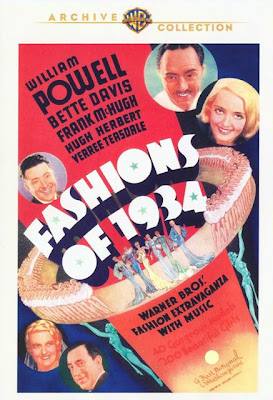FASHIONS OF 1934 (WB 1934) Warner Archive Collection

Bette Davis is
given the ultra-glam-bam treatment in William Dieterele's Fashions of 1934 (1934); a rather superfluous bit of claptrap and
utter nonsense that stars William Powell as a adorable con 'artiste'. The
screenplay by F. Hugh Herbert and Carl Erickson is a mindless, but passable
escapism that casts Powell as Sherwood Nash - a fraud whose investment firm has
just gone belly up. Sherwood's partner, Snap (Frank McHugh) is in a dither over
their sudden loss of income but rebounds quickly when he discovers Lynn Mason
(Bette Davis) waiting for the elevator. The elegant Lynn is desperately trying
to break into the fashion business but to no avail. Her predicament gives Nash
an angle he is all too willing to exploit.
Nash's
secretary Glenda (Dorothy Burgess) knows Harry Brent (Gordon Westcott) the
chauffeur of leading couturier Oscar Baroque (Reginald Owen). For a small
percentage Harry agrees to drive over Oscar's latest imports from Paris to
Nash's storefront before delivering them to his boss. Nash gets Glenda, Lynn
and a few other models to pose in the clothes. Snap takes their pictures and
Lynn feverishly works to design knock offs at a fraction of the price, thereby
undercutting Oscar and all the other designers in Manhattan. Eventually the
rouse is found out by Oscar. Harry is fired and Nash is threatened with prison.
But Nash has another angle. He will go to Paris and act as a spy for Oscar,
taking pictures of the leading Paris designs so that Oscar can beat them on the
runways back home.
Once on the
banks of the Seine, Lynn quickly discovers that Oscar's inspiration has come
from nothing more than second hand history books purchased from street vendors.
Barred from all the reputable fashion salons in Paris, Nash and Lynn decide to
open up the Maison Elegance with clothing designs by Lynn forged with Oscar's
signature. In the meantime, Nash comes to realize that Oscar's fiancée, the
Grand Duchess Alix (Verree Teasdale) is really Mabel McGuire, his old pal from
Hoboken New Jersey. Threatening her with exposure, Nash gets Mabel to star in
his musical revue, sporting a decadent gown of ostrich feathers. The review is
a smash hit but Oscar has arrived to learn the truth behind what's been going
on behind his back.
Oscar has Nash
arrested and Maison Elegance shut down. Lynn, who has been harboring affections
toward Nash for some time has had enough and vows never to speak to him again.
But Nash is the slippery sort. He takes the police to Oscar's lavish abode on
the eve of his wedding and confronts Oscar with the truth about Mabel.
Outraged, Oscar is forced to release Nash from incarceration or face fallout in
the tabloids from news of his sham marriage to a faux duchess. Nash dashes off
to the pier and catches the clipper bound for America. He reunites with Lynn
and vows to be true to her from now on. She forgives him and the two trot off
together, presumably reconciled and on their way to the altar.
Fashions of 1934 is billed as a musical comedy,
but actually it's more like a classic screwball with only one musical number to
recommend it. But what a number it is! Staged with aplomb by Busby Berkeley, 'Spin A Little Web of Dreams' is a
sumptuous fantasia of scantily clad girls preening in ostrich plumbs. Like all
of Berkeley's most inspired creations this one is a bizarre cornucopia of
conflicting imagery. The female form is re-imagined as everything from a
throbbing bud of a feather laden peony to a life size harp, and finally the bow
of a ship sailing on carpets of flowing silk bunting. Berkeley also stages a
sublime fashion show at Maison Elegance. A revolving platform of famous works
of art painted on transparent screens dissolve into living creations worn by
models who step beyond the paintings to parade about the forecourt, surrounded
by sycophantic admirers.
These two
production numbers help elevate Fashions
of 1934 above its rather conventional and not terribly prepossessing
comedic trappings. William Powell is in fine form as the affable cheat; slick
and stylish and in his element. But Bette Davis seems entirely out of place as
Lynn - her larger than life persona desperate to break away from the platinum
clothes horse concocted for her by Orry-Kelly. In the final analysis, Fashions of 1934 is a curious, but
effortlessly amusing film. Without Berkeley's touches of genius there would be
very little to recommend it.
Part of the
Warner Archive, Fashions of 1934
gets an adequate home video release. But something is decidedly wrong with the
title credits. After the 'First National' logo the screen suddenly goes black
for an instant before a title card reading 'William Powell in Fashions' appears
on a different backing than the rest of the main titles. This credit is held
over for an excruciatingly long time before the rest of the sequence continues
and it is my guess that this is a reissue title card plastered on for the
film's re-release some years later - presumably so that the film's original
title 'Fashions of 1934' would not
date the re-release.
It would have
been a nice touch if Warner Home Video had gone in search of the original title
sequence because this version of the main titles doesn't really work.
Otherwise, the transfer is middle of the road. Age related artifacts are
everywhere and occasionally distract. But the gray scale has been very nicely
balanced with strong blacks and clean whites, allowing William Rees' stylish
cinematography to shine through. The image is crisp without being digitally
harsh. All in all, a good effort. The audio is, of course, mono as originally
recorded but also in fine form. The only extra is a theatrical trailer.
FILM RATING (out of 5 - 5 being the best)
3
VIDEO/AUDIO
3.5
EXTRAS
0


Comments